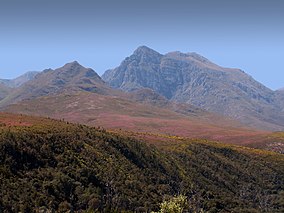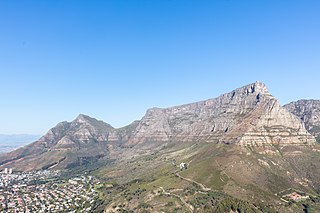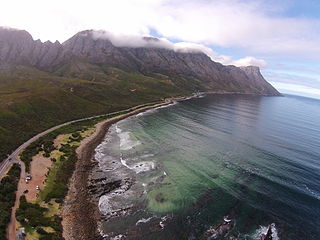| Boosmansbos Wilderness Area | |
|---|---|
Boosmansbos Wilderness Area, with Grootberg in the background | |
Map of Western Cape | |
| Location | Western Cape Province, South Africa |
| Nearest city | Heidelberg |
| Coordinates | 33°55′S20°52′E / 33.917°S 20.867°E Coordinates: 33°55′S20°52′E / 33.917°S 20.867°E |
| Area | 142 km2 (55 sq mi) |
| UNESCO World Heritage Site | |
| Criteria | Natural: (ix), (x) |
| Reference | 1007-006 |
| Inscription | 2004 (28th Session) |
| Extensions | 2015 |
The Boosmansbos Wilderness Area of 142 km2 (55 sq mi) is situated 20 km (12 mi) north of Heidelberg in the eastern Langeberg mountain chain of the Western Cape Province, South Africa. Boosmansbos, i.e. 'angry man's forest', is named after a resident hermit of the early 19th century who had been known to scare youngsters who visited his apiaries.

Heidelberg is a town in the Western Cape, South Africa. It is located near South Africa's south coast, on the N2 highway, 274 km east of Cape Town. Heidelberg is just east of the Overberg region, and some consider it the beginning of the Garden Route. Heidelberg is part of the Hessequa Local Municipality. Fourie House on Fourie Street is the oldest house in Heidelberg.

The Langeberg Range is a mountain range in the Western Cape province of South Africa. Its highest peak is Keeromsberg at 2075m and 15 km NE of the town of Worcester. Some of the highest peaks of the range are located just to the north of Swellendam, in a subrange known as the Clock Peaks whose highest point is 1710 m high Misty Point. Local lore states one can tell the time by means of the shadows cast by the seven summits of the Clock Peaks.

South Africa, officially the Republic of South Africa (RSA), is the southernmost country in Africa. It is bounded to the south by 2,798 kilometres (1,739 mi) of coastline of Southern Africa stretching along the South Atlantic and Indian Oceans; to the north by the neighbouring countries of Namibia, Botswana, and Zimbabwe; and to the east and northeast by Mozambique and Eswatini (Swaziland); and it surrounds the enclaved country of Lesotho. South Africa is the largest country in Southern Africa and the 25th-largest country in the world by land area and, with over 57 million people, is the world's 24th-most populous nation. It is the southernmost country on the mainland of the Old World or the Eastern Hemisphere. About 80 percent of South Africans are of Sub-Saharan African ancestry, divided among a variety of ethnic groups speaking different African languages, nine of which have official status. The remaining population consists of Africa's largest communities of European (White), Asian (Indian), and multiracial (Coloured) ancestry.
The elevation reaches 1,637 m (5,371 ft) at Grootberg peak, located at the center of the wilderness area. The tributaries of the Duiwenhoks River, which drain its southern slopes, tumble along precipitous gorges to 200 m (660 ft) above sea level on the southern perimeter. In the southwest the wilderness area encloses the Grootvadersbosch Nature Reserve of 250 ha (620 acres), the most western natural forest in South Africa.
Duiwenhoks River, located in Western Cape, South Africa, drains the Langeberg Mountains and flows south to the coast, entering the sea west of Mossel Bay in the Southern Cape. The river is approximately 83 km long with a catchment area of 1 340 km2. The Noukrans River is a tributary.

Mean sea level (MSL) is an average level of the surface of one or more of Earth's oceans from which heights such as elevation may be measured. MSL is a type of vertical datum – a standardised geodetic datum – that is used, for example, as a chart datum in cartography and marine navigation, or, in aviation, as the standard sea level at which atmospheric pressure is measured to calibrate altitude and, consequently, aircraft flight levels. A common and relatively straightforward mean sea-level standard is the midpoint between a mean low and mean high tide at a particular location.
The wilderness area conserves mountain fynbos and valley forest. Among the special fynbos plants conserved are Erica and everlasting species as well as the rare Langeberg rambling aloe. Important forest tree species occurring in the valleys are sickle-leaved yellowwood, stinkwood and red alder.

Fynbos is a small belt of natural shrubland or heathland vegetation located in the Western Cape and Eastern Cape provinces of South Africa. This area is predominantly winter rainfall coastal and mountainous areas with a Mediterranean climate. The fynbos ecoregion is within the Mediterranean forests, woodlands, and scrub biome. In fields related to biogeography, fynbos is known for its exceptional degree of biodiversity and endemism, consisting about 80% species of the Cape floral kingdom where nearly 6,000 of them are endemic. This land has faced severe threats and still does, but due to the many economic uses conservation efforts are being made to help restore it.

The Ericaceae are a family of flowering plants, commonly known as the heath or heather family, found most commonly in acid and infertile growing conditions. The family is large, with c. 4250 known species spread across 124 genera, making it the 14th most species-rich family of flowering plants. The many well-known and economically important members of the Ericaceae include the cranberry, blueberry, huckleberry, rhododendron, and various common heaths and heathers.

Aloiampelos decumbens, formerly Aloe decumbens, the Langeberg rambling-aloe, is a sprawling, succulent plant that is endemic to the fynbos vegetation of the Langeberg Mountains near Swellendam and Riversdale in the Western Cape, South Africa.
The area receives rain in any month of the year, although mid summer and mid winter are the driest, when hot bergwind conditions may occur. 64 km (40 mi) of footpaths allow access to the wilderness, among which a circular 27 km (17 mi) section which can be completed in two days.
















